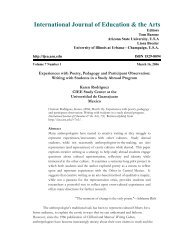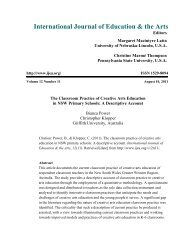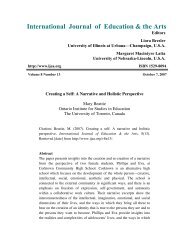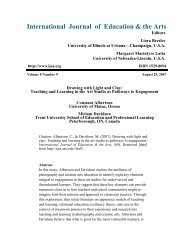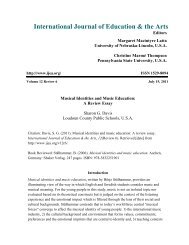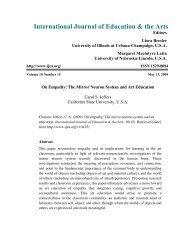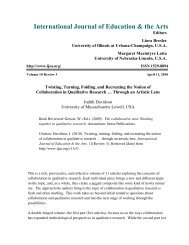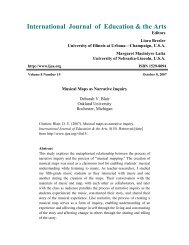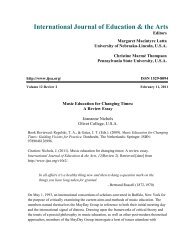The Rewards of Art Criticism in Art Education: A Review Essay ...
The Rewards of Art Criticism in Art Education: A Review Essay ...
The Rewards of Art Criticism in Art Education: A Review Essay ...
Create successful ePaper yourself
Turn your PDF publications into a flip-book with our unique Google optimized e-Paper software.
International Journal <strong>of</strong> <strong>Education</strong> & the <strong>Art</strong>s<br />
Editors<br />
Tom Barone<br />
Arizona State University, U.S.A<br />
Liora Bresler<br />
University <strong>of</strong> Ill<strong>in</strong>ois at Urbana—Champaign, U.S.A.<br />
http://ijea.asu.edu ISBN 1529-8094<br />
Volume 7 <strong>Review</strong> 2 April 26, 2006<br />
<strong>The</strong> <strong>Rewards</strong> <strong>of</strong> <strong>Art</strong> <strong>Criticism</strong> <strong>in</strong> <strong>Art</strong> <strong>Education</strong>:<br />
A <strong>Review</strong> <strong>Essay</strong><br />
Tracie E. Costant<strong>in</strong>o<br />
University <strong>of</strong> Georgia<br />
Barrett, T. (2003). Interpret<strong>in</strong>g art: Reflect<strong>in</strong>g, wonder<strong>in</strong>g, and<br />
respond<strong>in</strong>g. NY: McGraw-Hill.<br />
262 pages<br />
$25.31 ISBN: 0-7674-1648-1<br />
Citation: Costant<strong>in</strong>o, T. E. (2006, April 26). <strong>The</strong> rewards <strong>of</strong> art criticism <strong>in</strong><br />
art education: A review essay. International Journal <strong>of</strong> <strong>Education</strong> & the <strong>Art</strong>s,<br />
7(<strong>Review</strong> 2). Retrieved [date] from http://ijea.asu.edu/v7r2/.<br />
In order to facilitate students’ mean<strong>in</strong>g mak<strong>in</strong>g with art there are several<br />
models <strong>of</strong> art criticism developed for art education, such as Feldman’s model (1970),<br />
the fem<strong>in</strong>ist model (e.g., Garber, 1990) and the structuralist educational model<br />
(Anderson, 1993). In his book, Interpret<strong>in</strong>g <strong>Art</strong>: Reflect<strong>in</strong>g, Wonder<strong>in</strong>g, and Respond<strong>in</strong>g, Terry<br />
Barrett does not so much put forth a model (he has done this elsewhere, see Barrett,<br />
1997) as model for the reader the rewards, <strong>in</strong>tellectual and emotional, <strong>of</strong> <strong>in</strong>terpret<strong>in</strong>g<br />
art. He asserts, “Self-knowledge can come through <strong>in</strong>terpret<strong>in</strong>g works <strong>of</strong> art, those that<br />
we are drawn to and those that may repel us” (p. xvii). <strong>The</strong>se rewards may be fostered<br />
by attend<strong>in</strong>g to a set <strong>of</strong> 19 pr<strong>in</strong>ciples Barrett explores throughout the book. 1<br />
1 <strong>The</strong> 19 pr<strong>in</strong>ciples are: a) artworks are always about someth<strong>in</strong>g; b) subject matter + form +<br />
context = mean<strong>in</strong>g; c) to <strong>in</strong>terpret a work <strong>of</strong> art is to understand it <strong>in</strong> language; d) feel<strong>in</strong>gs are<br />
guides to <strong>in</strong>terpretation; e) the critical activities <strong>of</strong> describ<strong>in</strong>g, analyz<strong>in</strong>g, <strong>in</strong>terpret<strong>in</strong>g, judg<strong>in</strong>g,<br />
and theoriz<strong>in</strong>g about works <strong>of</strong> art are <strong>in</strong>terrelated and <strong>in</strong>terdependent; f) artworks attract<br />
multiple <strong>in</strong>terpretations and it is not the goal <strong>of</strong> <strong>in</strong>terpretation to arrive at s<strong>in</strong>gle, grand, unified,<br />
composite <strong>in</strong>terpretations; g) there is a range <strong>of</strong> <strong>in</strong>terpretations any artwork will allow; h)
http://ijea.asu.edu/v7r2/ 2<br />
In this review I will analyze Barrett’s approach to <strong>in</strong>terpretation. Through his<br />
model<strong>in</strong>g <strong>of</strong> the 19 pr<strong>in</strong>ciples, Barrett exemplifies a passion for <strong>in</strong>quiry and artistic<br />
expression that is important to highlight as it may <strong>in</strong>spire art educators who want to<br />
conduct engag<strong>in</strong>g and mean<strong>in</strong>gful criticism with their students. While all 19 pr<strong>in</strong>ciples<br />
are critical, I will focus on six, specifically those relat<strong>in</strong>g to multiplicity <strong>of</strong><br />
<strong>in</strong>terpretation, and the need for reasonable <strong>in</strong>terpretations that correspond to a<br />
particular work <strong>of</strong> art.<br />
1. <strong>Art</strong>works attract multiple <strong>in</strong>terpretations and it is not the goal <strong>of</strong><br />
<strong>in</strong>terpretation to arrive at s<strong>in</strong>gle, grand, unified, composite <strong>in</strong>terpretations<br />
2. <strong>The</strong>re is a range <strong>of</strong> <strong>in</strong>terpretations any artwork will allow<br />
3. Interpretations are not so much right, but are more or less reasonable,<br />
conv<strong>in</strong>c<strong>in</strong>g, <strong>in</strong>formative, and enlighten<strong>in</strong>g<br />
4. Good <strong>in</strong>terpretations tell more about the artwork than they tell about the<br />
<strong>in</strong>terpreter<br />
5. Some <strong>in</strong>terpretations are better than others<br />
6. <strong>The</strong> admissibility <strong>of</strong> an <strong>in</strong>terpretation is ultimately determ<strong>in</strong>ed by a<br />
community <strong>of</strong> <strong>in</strong>terpreters and the community is self-correct<strong>in</strong>g<br />
I have selected to focus on these six because Barrett does a particularly good job <strong>of</strong><br />
address<strong>in</strong>g the relativism that might exist <strong>in</strong> some K-12 art education classrooms where<br />
there are “no wrong answers.” I th<strong>in</strong>k it may be useful to art educators to understand<br />
how Barrett encourages a multitude <strong>of</strong> <strong>in</strong>terpretations while requir<strong>in</strong>g correspondence<br />
with the work <strong>of</strong> art. In order to explicate his ideas I will provide a brief outl<strong>in</strong>e <strong>of</strong> the<br />
book. <strong>The</strong>n, I will present an analysis <strong>of</strong> Barrett’s approach to <strong>in</strong>terpret<strong>in</strong>g art and<br />
suggest some practical applications. Next, I will discuss the six pr<strong>in</strong>ciples listed above.<br />
F<strong>in</strong>ally, I conclude with a discussion <strong>of</strong> the transformative potential <strong>of</strong> <strong>in</strong>terpret<strong>in</strong>g art.<br />
A Brief Outl<strong>in</strong>e<br />
<strong>The</strong>re are seven chapters that explore the 19 pr<strong>in</strong>ciples <strong>of</strong> <strong>in</strong>terpretation and an<br />
eighth chapter that summarizes the pr<strong>in</strong>ciples and ma<strong>in</strong> po<strong>in</strong>ts <strong>of</strong> the book. Barrett<br />
encourages the reader to go through the book as needed, suggest<strong>in</strong>g that one may start<br />
mean<strong>in</strong>gs <strong>of</strong> artworks are not limited to what their artists <strong>in</strong>tended them to mean; i)<br />
<strong>in</strong>terpretations are not so much right, but are more or less reasonable, conv<strong>in</strong>c<strong>in</strong>g, <strong>in</strong>formative,<br />
and enlighten<strong>in</strong>g; j) <strong>in</strong>terpretations imply a worldview; k) good <strong>in</strong>terpretations tell more about<br />
the artwork than they tell about the <strong>in</strong>terpreter; l) the objects <strong>of</strong> <strong>in</strong>terpretation are artworks,<br />
not artists; m) all art is <strong>in</strong> part about the world <strong>in</strong> which it emerged; n) all art is <strong>in</strong> part about<br />
other art; o) good <strong>in</strong>terpretations have coherence, correspondence, and <strong>in</strong>clusiveness; p)<br />
<strong>in</strong>terpret<strong>in</strong>g art is an endeavor that is both <strong>in</strong>dividual and communal; q) some <strong>in</strong>terpretations<br />
are better than others; r) the admissibility <strong>of</strong> an <strong>in</strong>terpretation is ultimately determ<strong>in</strong>ed by a<br />
community <strong>of</strong> <strong>in</strong>terpreters and the community is self-correct<strong>in</strong>g; s) good <strong>in</strong>terpretations <strong>in</strong>vite<br />
us to see for ourselves and cont<strong>in</strong>ue on our own.
http://ijea.asu.edu/v7r2/ 3<br />
with the eighth chapter to get an overview <strong>of</strong> the pr<strong>in</strong>ciples and then focus on another<br />
chapter <strong>of</strong> particular <strong>in</strong>terest. 2 Barrett demonstrates these pr<strong>in</strong>ciples with rich<br />
examples, draw<strong>in</strong>g from pr<strong>of</strong>essional art critics’ <strong>in</strong>terpretations, <strong>in</strong>terpretations by<br />
scholars <strong>of</strong> other discipl<strong>in</strong>es, student <strong>in</strong>terpretations, and model<strong>in</strong>g his own<br />
<strong>in</strong>terpretations.<br />
In the first chapter Barrett models his approach to <strong>in</strong>terpretation (to be<br />
discussed below) by focus<strong>in</strong>g on <strong>The</strong> Postcard by René Magritte. In this chapter he<br />
<strong>in</strong>cludes <strong>in</strong>terpretations by art historians as well as fourth grade and high school<br />
students. In chapter two, utiliz<strong>in</strong>g the <strong>in</strong>terpretations <strong>of</strong> art historians, Barrett<br />
demonstrates how one work <strong>of</strong> art (Edouard Manet’s A Bar at the Folies-Bergère) can<br />
have multiple reasonable <strong>in</strong>terpretations. Chapter three explores <strong>in</strong>terpretations <strong>of</strong><br />
controversial art, emphasiz<strong>in</strong>g how <strong>in</strong>terpretation and judgment are <strong>in</strong>terdependent.<br />
Chapter four <strong>in</strong>vestigates how to <strong>in</strong>terpret abstract art. Chapter five discusses<br />
<strong>in</strong>terpret<strong>in</strong>g old and foreign art. Chapter six concentrates on <strong>in</strong>terpret<strong>in</strong>g a particular<br />
medium, photography, which draws on Barrett’s expertise <strong>in</strong> this art form (see Barrett,<br />
2000). Chapter seven provides <strong>in</strong>terdiscipl<strong>in</strong>ary <strong>in</strong>terpretations with, for example, a<br />
short story <strong>in</strong>spired by Edward Hopper’s pa<strong>in</strong>t<strong>in</strong>g Cape Cod Even<strong>in</strong>g, an <strong>in</strong>terpretation<br />
<strong>of</strong> a dance, and a critique <strong>of</strong> visual culture, <strong>in</strong>clud<strong>in</strong>g <strong>The</strong> Little Mermaid. In this chapter<br />
Barrett ensures he has provided a pluralistic perspective <strong>in</strong> the book as he rounds out<br />
the k<strong>in</strong>ds <strong>of</strong> art discussed throughout with a look at popular and visual culture,<br />
architecture, cartoons, decorative arts, and a wonderful <strong>in</strong>terpretive vignette by<br />
Spald<strong>in</strong>g Gray <strong>of</strong> a conversation between parent and child. Indeed, Barrett stresses<br />
that, “This book supports a pluralistic approach to art and aesthetic values as liberat<strong>in</strong>g<br />
and expansive” (p. 86).<br />
<strong>The</strong> eighth chapter is a summary and concrete discussion <strong>of</strong> the 19 pr<strong>in</strong>ciples<br />
and the rewards <strong>of</strong> <strong>in</strong>terpret<strong>in</strong>g art. It is as a strong conclusion <strong>of</strong> Barrett’s ideas about<br />
<strong>in</strong>terpret<strong>in</strong>g art, and his <strong>in</strong>tentions for this book, that is “to encourage readers to make<br />
art relevant to their lives through <strong>in</strong>terpretations” (p. 119). He encourages readers by<br />
model<strong>in</strong>g the <strong>in</strong>tellectual and emotional engagement <strong>of</strong> <strong>in</strong>terpretation and explicat<strong>in</strong>g<br />
the 19 pr<strong>in</strong>ciples as guidel<strong>in</strong>es.<br />
Barrett’s Approach to Interpretation<br />
In chapter one Barrett uses a th<strong>in</strong>k-aloud process while <strong>in</strong>terpret<strong>in</strong>g Magritte’s<br />
pa<strong>in</strong>t<strong>in</strong>g <strong>The</strong> Postcard. He beg<strong>in</strong>s by discuss<strong>in</strong>g what he knows about the pa<strong>in</strong>t<strong>in</strong>g—<br />
historical <strong>in</strong>formation about Magritte and Surrealism. Barrett emphasizes that<br />
Magritte’s pa<strong>in</strong>t<strong>in</strong>g is <strong>of</strong> his time—it is from a Western European culture and pa<strong>in</strong>ted<br />
dur<strong>in</strong>g the twentieth century; therefore he is more comfortable undertak<strong>in</strong>g this<br />
2 I first approached the book <strong>in</strong> this way as I was do<strong>in</strong>g research on methods <strong>of</strong> art criticism <strong>in</strong><br />
art education, but I found it much more compell<strong>in</strong>g to see these pr<strong>in</strong>ciples demonstrated<br />
consecutively through the chapters <strong>of</strong> the book <strong>in</strong>stead <strong>of</strong> out <strong>of</strong> context <strong>in</strong> the last chapter.
http://ijea.asu.edu/v7r2/ 4<br />
<strong>in</strong>terpretation. If it were from another time and very different culture, he would need<br />
to be oriented to the artwork through contextual clues found <strong>in</strong> others’ knowledge (p.<br />
4). His process is guided by a series <strong>of</strong> questions, beg<strong>in</strong>n<strong>in</strong>g with what he calls a literal<br />
read<strong>in</strong>g <strong>of</strong> the pa<strong>in</strong>t<strong>in</strong>g: “What do I see What do I feel when I look at it Does it have<br />
personal significance for me” (p. 2). <strong>The</strong>se questions are similar to the descriptive<br />
stage <strong>in</strong> other models <strong>of</strong> art criticism, but Barrett does not restrict himself by<br />
exhaustively list<strong>in</strong>g observations, but quickly starts to construct an <strong>in</strong>terpretation based<br />
on a summary statement <strong>of</strong> what he sees <strong>in</strong> the pa<strong>in</strong>t<strong>in</strong>g, “In <strong>The</strong> Postcard, I see a large<br />
green apple <strong>in</strong> the sky above the head <strong>of</strong> a man wear<strong>in</strong>g a black coat and stand<strong>in</strong>g<br />
before a stone wall that is between him and a mounta<strong>in</strong> range” (p. 4). He wonders<br />
about the relationship between the apple and the man, “Maybe the apple is <strong>in</strong> his<br />
imag<strong>in</strong>ation, and that is what I am see<strong>in</strong>g. Perhaps the apple imag<strong>in</strong>es him!” (p. 4).<br />
Barrett then moves on to a metaphoric read<strong>in</strong>g <strong>of</strong> the pa<strong>in</strong>t<strong>in</strong>g, concentrat<strong>in</strong>g on the<br />
apple as symbol. He bra<strong>in</strong>storms about various symbolic connotations <strong>of</strong> the apple,<br />
from the symbol <strong>of</strong> knowledge <strong>in</strong> the Garden <strong>of</strong> Eden, to the apple that fell from the<br />
tree onto Newton’s head, symboliz<strong>in</strong>g gravity. He decides on the Newtonian reference<br />
as the most plausible, “<strong>The</strong> most notable properties <strong>of</strong> this apple are its <strong>in</strong>congruously<br />
huge size, its placement <strong>in</strong> the sky, and especially its seem<strong>in</strong>g ability to be airborne,<br />
suspended <strong>in</strong> denial <strong>of</strong> gravity” (p. 6). This <strong>in</strong>terpretation is further supported when<br />
one considers the Surrealists’ challenge to the dom<strong>in</strong>ance <strong>of</strong> reason s<strong>in</strong>ce the<br />
Enlightenment, with Newton be<strong>in</strong>g a lead<strong>in</strong>g figure <strong>of</strong> this era. Hence, Barrett unites<br />
his literal observations <strong>of</strong> the visual characteristics <strong>of</strong> the apple <strong>in</strong> the pa<strong>in</strong>t<strong>in</strong>g with his<br />
knowledge <strong>of</strong> the apple as a contextualized symbol to develop a plausible<br />
<strong>in</strong>terpretation. Looked at differently, he attempts to develop an <strong>in</strong>terpretation that<br />
makes sense with the visual evidence <strong>in</strong> the pa<strong>in</strong>t<strong>in</strong>g and with<strong>in</strong> the context <strong>of</strong> its<br />
creation.<br />
At this po<strong>in</strong>t, Barrett has drawn on prior knowledge and observations <strong>of</strong> the<br />
pa<strong>in</strong>t<strong>in</strong>g to construct his <strong>in</strong>terpretation. Cognition is fundamentally metaphoric (Lak<strong>of</strong>f<br />
& Johnson, 1999) and to understand an image one moves between the literal and<br />
symbolic. <strong>The</strong>refore, Barrett moves back and forth between “the denotational and the<br />
connotational” (p.5), which is especially important with such an ambiguous image as<br />
the Magritte pa<strong>in</strong>t<strong>in</strong>g.<br />
Hav<strong>in</strong>g conducted a thorough visual analysis <strong>of</strong> the pa<strong>in</strong>t<strong>in</strong>g supported by prior<br />
knowledge, Barrett looks beyond <strong>The</strong> Postcard to further his understand<strong>in</strong>g <strong>of</strong> the<br />
pa<strong>in</strong>t<strong>in</strong>g. He asks, “Has Magritte used apples <strong>in</strong> his other works, and would they be<br />
<strong>in</strong>formative <strong>in</strong> <strong>in</strong>terpret<strong>in</strong>g this work” (p. 6). Barrett does not <strong>in</strong>terpret this pa<strong>in</strong>t<strong>in</strong>g <strong>in</strong><br />
isolation, but considers it with<strong>in</strong> the context <strong>of</strong> Magritte’s oeuvre. He does an Internet<br />
search for Magritte images with apples, a research technique familiar to many students,<br />
and compares them to <strong>The</strong> Postcard. Significantly, Barrett decides this research is both<br />
helpful and unhelpful, as it reveals the diversity with which Magritte used apples <strong>in</strong> his
http://ijea.asu.edu/v7r2/ 5<br />
work, but without <strong>of</strong>fer<strong>in</strong>g a unify<strong>in</strong>g theme. This is confound<strong>in</strong>g, but reveal<strong>in</strong>g <strong>of</strong> the<br />
complexity <strong>of</strong> an artist’s artistic production. Yet, the research has been worthwhile, as<br />
it has given Barrett a much larger context with<strong>in</strong> which to understand <strong>The</strong> Postcard, and,<br />
importantly, stimulates his <strong>in</strong>terest <strong>in</strong> Magritte’s art so that he desires to learn more.<br />
Barrett turns to scholarly <strong>in</strong>terpretations <strong>of</strong> Magritte’s work for further <strong>in</strong>sight,<br />
read<strong>in</strong>g <strong>in</strong>terpretations by Suzi Gablik, and the follow<strong>in</strong>g authors whose work builds<br />
on hers: Todd Alden, Jacques Meuris, and A.M. Hammacher. Accord<strong>in</strong>g to Barrett,<br />
this type <strong>of</strong> research helps the <strong>in</strong>terpreter gauge the importance <strong>of</strong> <strong>The</strong> Postcard <strong>in</strong><br />
Magritte’s oeuvre and provides “a k<strong>in</strong>d <strong>of</strong> scaffold<strong>in</strong>g for understand<strong>in</strong>g by which we<br />
can apprehend Magritte’s work” (p. 30).<br />
He concludes his <strong>in</strong>vestigation <strong>of</strong> <strong>The</strong> Postcard by present<strong>in</strong>g the <strong>in</strong>terpretations<br />
<strong>of</strong> Magritte’s art by elementary and high school students and their teachers. He wants<br />
to emphasize that the viewer does not need to be an art historian or other scholar to<br />
develop a mean<strong>in</strong>gful and plausible <strong>in</strong>terpretation. His po<strong>in</strong>t is especially persuasive<br />
when he demonstrates that the students’ <strong>in</strong>terpretations were comprehensive and<br />
compatible with those by the scholars <strong>of</strong> Magritte’s work (p. 31).<br />
<strong>Review</strong><strong>in</strong>g the above discussion, certa<strong>in</strong> characteristics <strong>of</strong> Barrett’s approach<br />
become evident. First, Barrett exhibits an engagement with and s<strong>in</strong>cere <strong>in</strong>tellectual<br />
curiosity about the artwork. This fundamental quality that Barrett exemplifies is “a<br />
disposition to <strong>in</strong>terpret, a positive will<strong>in</strong>gness to engage <strong>in</strong> thought about a work <strong>of</strong><br />
art” (p. 36). If art educators can demonstrate this k<strong>in</strong>d <strong>of</strong> engagement and <strong>in</strong>tellectual<br />
curiosity <strong>in</strong> their classrooms they will create an environment primed for dynamic<br />
critical discussions <strong>of</strong> art.<br />
Secondly, Barrett’s approach is centered on <strong>in</strong>quiry and knowledge. Barrett<br />
beg<strong>in</strong>s by reflect<strong>in</strong>g on what he knows about Magritte and the artistic milieu <strong>in</strong> which<br />
he worked. He then analyzes the pa<strong>in</strong>t<strong>in</strong>g, mov<strong>in</strong>g back and forth between a literal and<br />
metaphoric read<strong>in</strong>g. Dur<strong>in</strong>g this analysis he draws on prior knowledge and considers<br />
how other works by Magritte and the <strong>in</strong>terpretations <strong>of</strong> others’ might <strong>in</strong>form his<br />
understand<strong>in</strong>g <strong>of</strong> the pa<strong>in</strong>t<strong>in</strong>g. He conducts research to m<strong>in</strong>e these resources for<br />
<strong>in</strong>sight and then constructs an <strong>in</strong>terpretation based on this work. This relates to the<br />
<strong>in</strong>structional strategy <strong>of</strong> KWL (Know, Wonder, Learn) used <strong>in</strong> constructivist learn<strong>in</strong>g<br />
approaches such as Problem-Based Learn<strong>in</strong>g (PBL) [for an application <strong>of</strong> PBL to art<br />
education see Costant<strong>in</strong>o, 2002]). <strong>Art</strong> educators could apply this strategy to help<br />
students conduct the k<strong>in</strong>d <strong>of</strong> research <strong>in</strong>tegral to Barrett’s approach to art criticism.<br />
KWL is useful for develop<strong>in</strong>g a conceptual map for <strong>in</strong>quiry—what does a student<br />
know about a topic, what does the students wonder about, and what has the student<br />
learned through research It is an iterative process, so that KWL can provide a<br />
structure for the cyclical nature <strong>of</strong> research. Furthermore, it is through this <strong>in</strong>quiry that<br />
Barrett sees the rewards <strong>of</strong> <strong>in</strong>terpret<strong>in</strong>g art, “those who <strong>in</strong>terpret [art] seem rewarded
http://ijea.asu.edu/v7r2/ 6<br />
<strong>in</strong> their efforts with <strong>in</strong>tr<strong>in</strong>sic enjoyment <strong>of</strong> the pursuit, ga<strong>in</strong> new <strong>in</strong>sights <strong>in</strong>to the world<br />
and their experiences <strong>of</strong> it, and are even <strong>in</strong>spired to change how they live” (p. 36).<br />
F<strong>in</strong>ally, for Barrett it is critical to articulate one’s response to the artwork. He<br />
facilitates this with the elementary and high school students when he asks them to<br />
write their <strong>in</strong>terpretations <strong>of</strong> Magritte’s pa<strong>in</strong>t<strong>in</strong>gs. He expla<strong>in</strong>s, “When writ<strong>in</strong>g or tell<strong>in</strong>g<br />
about what we see and what we experience <strong>in</strong> the presence <strong>of</strong> an artwork, we build<br />
mean<strong>in</strong>g; we do not merely report it” (p. 202). <strong>Art</strong>iculation <strong>of</strong> visual and verbal <strong>in</strong>quiry<br />
is part <strong>of</strong> the <strong>in</strong>terpretive process. Barrett does not discuss how an artistic response<br />
might also be an articulation <strong>of</strong> an <strong>in</strong>terpretation (although he does reference artistic<br />
responses <strong>in</strong> the last chapter).<br />
Barrett’s approach may be summed up by the words that are central to the title<br />
<strong>of</strong> the book—reflect<strong>in</strong>g, wonder<strong>in</strong>g, and respond<strong>in</strong>g. He reflects on what he knows<br />
about the artist, the context <strong>in</strong> which he worked, and what he sees <strong>in</strong> the pa<strong>in</strong>t<strong>in</strong>g,<br />
literally and metaphorically. He wonders what he can learn through research guided by<br />
<strong>in</strong>quiry questions. Based on prior experiences and new knowledge he constructs an<br />
<strong>in</strong>terpretation and articulates it verbally—this is his response to the pa<strong>in</strong>t<strong>in</strong>g.<br />
Barrett concludes the first chapter by describ<strong>in</strong>g what he considers to be a<br />
good <strong>in</strong>terpretation <strong>of</strong> a work <strong>of</strong> art. It is worth reproduc<strong>in</strong>g here as it lays out, <strong>in</strong><br />
general, the pr<strong>in</strong>ciples he will explicate <strong>in</strong> the rest <strong>of</strong> the book.<br />
In general, good <strong>in</strong>terpretations are those that satisfactorily provide<br />
answers to questions <strong>of</strong> mean<strong>in</strong>g posed by viewers <strong>in</strong> response to works.<br />
A good <strong>in</strong>terpretation is one that satisfies your curiosity about the<br />
artwork that is <strong>of</strong> <strong>in</strong>terest to you. It is one that clearly relates to what<br />
you can see <strong>in</strong> the work, one that expands your experience <strong>of</strong> the work,<br />
one that leads you to th<strong>in</strong>k further about artworks and ideas, and one<br />
that motivates you to explore more artworks and ideas on your own. A<br />
good <strong>in</strong>terpretation is one that gives you knowledge about the work and<br />
about the world and about yourself as an explorer <strong>of</strong> works and worlds,<br />
one that is satisfy<strong>in</strong>g to others who are <strong>in</strong>terested <strong>in</strong> the work, and one<br />
that allows you to make mean<strong>in</strong>gful connections between Magritte’s<br />
work, for example, and the th<strong>in</strong>k<strong>in</strong>g <strong>of</strong> others as expressed <strong>in</strong> [other<br />
discipl<strong>in</strong>es]…<br />
<strong>The</strong> position <strong>of</strong> this book is that there is no s<strong>in</strong>gle right <strong>in</strong>terpretation<br />
for <strong>The</strong> Postcard, for example, nor will there be one forthcom<strong>in</strong>g, but that<br />
some <strong>in</strong>terpretations <strong>of</strong> <strong>The</strong> Postcard are nevertheless better than others:<br />
that is, more <strong>in</strong>sightful, better conceived, more responsive to what is <strong>in</strong><br />
the pa<strong>in</strong>t<strong>in</strong>g and <strong>in</strong> harmony with the societal and <strong>in</strong>tellectual milieu <strong>in</strong><br />
which the pa<strong>in</strong>t<strong>in</strong>g was produced. (p. 37)
http://ijea.asu.edu/v7r2/ 7<br />
Thus, a good <strong>in</strong>terpretation is personally mean<strong>in</strong>gful while also correspond<strong>in</strong>g<br />
to the work’s visual elements and socio-cultural milieu. It is <strong>in</strong>tellectually and<br />
emotionally satisfy<strong>in</strong>g and generates knowledge and <strong>in</strong>sight. Also, the <strong>in</strong>terpretation<br />
has communal relevance—it makes sense to others <strong>in</strong>terested <strong>in</strong> the work and has<br />
<strong>in</strong>terdiscipl<strong>in</strong>ary applications. A good <strong>in</strong>terpretation is developed through openness to<br />
the act <strong>of</strong> <strong>in</strong>terpretation, a sense <strong>of</strong> wonder, keen observation, <strong>in</strong>quiry, and a<br />
construction <strong>of</strong> understand<strong>in</strong>g that can be shared with others. This aspect <strong>of</strong><br />
community, which draws on and provides a pluralism <strong>of</strong> ideas <strong>in</strong> a collaborative effort<br />
to understand art, will be exam<strong>in</strong>ed more closely by discuss<strong>in</strong>g six <strong>of</strong> Barrett’s 19<br />
pr<strong>in</strong>ciples.<br />
Focus on Multiplicity and Reasonableness: Pr<strong>in</strong>ciples for Interpret<strong>in</strong>g <strong>Art</strong><br />
Barrett states the premise <strong>of</strong> the book on the first page, “Anyone can engage <strong>in</strong><br />
mean<strong>in</strong>gful <strong>in</strong>terpretive thought and <strong>in</strong> mean<strong>in</strong>gful <strong>in</strong>terpretive talk about works <strong>of</strong> art<br />
and that multiple <strong>in</strong>terpretations are better than s<strong>in</strong>gle <strong>in</strong>terpretations” (p. 1). This<br />
statement <strong>in</strong>troduces the valu<strong>in</strong>g <strong>of</strong> pluralism central to Barrett’s approach to art<br />
criticism and his emphasis on <strong>in</strong>terpret<strong>in</strong>g art as a lifelong pursuit <strong>in</strong> which anyone can<br />
engage with <strong>in</strong>sightful and reward<strong>in</strong>g results. However, with<strong>in</strong> this valu<strong>in</strong>g <strong>of</strong> pluralism,<br />
or multiplicity, is a clear commitment to the “rights <strong>of</strong> the text.” Here Barrett cites<br />
Umberto Eco, who argues that every artwork sets limits as to how it can be <strong>in</strong>terpreted<br />
(p. 209). <strong>The</strong> follow<strong>in</strong>g six pr<strong>in</strong>ciples relate to the importance <strong>of</strong> develop<strong>in</strong>g an<br />
<strong>in</strong>terpretation reflect<strong>in</strong>g what may be seen <strong>in</strong> a work <strong>of</strong> art, and correspond<strong>in</strong>g with<br />
what is known <strong>of</strong> the social, historic and <strong>in</strong>tellectual context from which the artwork<br />
developed,<br />
1. <strong>Art</strong>works attract multiple <strong>in</strong>terpretations and it is not the goal <strong>of</strong><br />
<strong>in</strong>terpretation to arrive at s<strong>in</strong>gle, grand, unified, composite <strong>in</strong>terpretations<br />
2. <strong>The</strong>re is a range <strong>of</strong> <strong>in</strong>terpretations any artwork will allow<br />
3. Interpretations are not so much right, but are more or less reasonable,<br />
conv<strong>in</strong>c<strong>in</strong>g, <strong>in</strong>formative, and enlighten<strong>in</strong>g<br />
4. Good <strong>in</strong>terpretations tell more about the artwork than they tell about the<br />
<strong>in</strong>terpreter<br />
5. Some <strong>in</strong>terpretations are better than others<br />
6. <strong>The</strong> admissibility <strong>of</strong> an <strong>in</strong>terpretation is ultimately determ<strong>in</strong>ed by a<br />
community <strong>of</strong> <strong>in</strong>terpreters and the community is self-correct<strong>in</strong>g<br />
<strong>The</strong> first five pr<strong>in</strong>ciples emphasize that artworks encourage multiple<br />
<strong>in</strong>terpretations and assert that it is not desirable to develop one “correct”<br />
<strong>in</strong>terpretation. Accord<strong>in</strong>g to Barrett, “Differ<strong>in</strong>g <strong>in</strong>terpretations <strong>of</strong> the same work <strong>of</strong> art<br />
stand alongside each other and can attract our attention to different features <strong>of</strong> the
http://ijea.asu.edu/v7r2/ 8<br />
same work” (p. 206). In fact, the goal is not to be “correct,” rather the central goal for<br />
an <strong>in</strong>terpretation has three ma<strong>in</strong> tenets:<br />
1) it makes sense with what one sees <strong>in</strong> the artwork and knows about the artist<br />
and artwork’s milieu,<br />
2) the <strong>in</strong>terpretation is presented with evidence (e.g., observational, art<br />
historical) allow<strong>in</strong>g for the development <strong>of</strong> a conv<strong>in</strong>c<strong>in</strong>g argument, and<br />
importantly,<br />
3) the <strong>in</strong>terpretation is mean<strong>in</strong>gful and <strong>in</strong>sightful to both the <strong>in</strong>terpreter and<br />
others.<br />
While it should be mean<strong>in</strong>gful to the <strong>in</strong>terpreter, and reflect the <strong>in</strong>terpreter’s<br />
knowledge, the <strong>in</strong>terpretation should not be more reveal<strong>in</strong>g <strong>of</strong> the <strong>in</strong>terpreter than the<br />
artwork. Barrett expla<strong>in</strong>s, “An <strong>in</strong>terpretation that is too personal is one that does not<br />
shed any light on the object that is be<strong>in</strong>g <strong>in</strong>terpreted” (p. 224).<br />
Barrett gives the example <strong>of</strong> the countless number <strong>of</strong> scholarly, written<br />
<strong>in</strong>terpretations <strong>of</strong> Hamlet, as well as the artistic <strong>in</strong>terpretations by directors and actors.<br />
S<strong>in</strong>ce Shakespeare did not write about his own work or life, rely<strong>in</strong>g on artist <strong>in</strong>tent<br />
would not yield relevant or <strong>in</strong>sightful <strong>in</strong>terpretations. Instead, the scholarly and artistic<br />
<strong>in</strong>terpretations have been guided by different <strong>in</strong>terpretive questions, yield<strong>in</strong>g different,<br />
but relevant <strong>in</strong>terpretations. <strong>The</strong>se varied and <strong>in</strong>sightful <strong>in</strong>terpretations, “are to be<br />
valued and…it would be a great loss to art and to humanity if they were all somehow<br />
replaced by one <strong>in</strong>terpretation…” (p. 206). Barrett emphasizes that we all come to<br />
works <strong>of</strong> art with certa<strong>in</strong> cultural constants as well as <strong>in</strong>dividual life experiences and<br />
that these experiences affect our <strong>in</strong>terpretations.<br />
This is a good th<strong>in</strong>g. We are varied, and our responses to works <strong>of</strong> art will be varied.<br />
When we share our <strong>in</strong>dividual responses to works <strong>of</strong> art with others, we <strong>of</strong>fer what can<br />
be uniquely nuanced responses that can enlarge understand<strong>in</strong>gs <strong>of</strong> the work <strong>of</strong> art for<br />
all who hear us. (p. 208)<br />
For art educators concerned about valu<strong>in</strong>g their students’ diverse ideas and not<br />
discourag<strong>in</strong>g them with admonitions <strong>of</strong> right or wrong, Barrett expla<strong>in</strong>s how a plurality<br />
<strong>of</strong> ideas can enlarge understand<strong>in</strong>g <strong>of</strong> a work <strong>of</strong> art. <strong>Art</strong> educators can guide their<br />
students to apply their diverse understand<strong>in</strong>gs <strong>in</strong> a plausible <strong>in</strong>terpretation by<br />
recogniz<strong>in</strong>g that, “history and culture limit the range <strong>of</strong> <strong>in</strong>terpretations that are<br />
allowable” (p. 209). In other words, it is important for students and art educators to<br />
keep <strong>in</strong> m<strong>in</strong>d that an artwork is made at a certa<strong>in</strong> time and <strong>in</strong> a specific culture by an<br />
<strong>in</strong>dividual person with a particular life experience. In addition to the formal elements<br />
and iconography <strong>of</strong> an artwork, all <strong>of</strong> these th<strong>in</strong>gs must be considered. An art educator<br />
can help his or her students develop <strong>in</strong>sightful and reasonable <strong>in</strong>terpretations by
http://ijea.asu.edu/v7r2/ 9<br />
closely “read<strong>in</strong>g” the literal and symbolic elements <strong>of</strong> an artwork and conduct<strong>in</strong>g<br />
research on the context <strong>in</strong> which it was made. <strong>The</strong> new knowledge generated through<br />
observation and <strong>in</strong>quiry jo<strong>in</strong>s with students’ prior knowledge to create a unique and<br />
<strong>in</strong>sightful <strong>in</strong>terpretation grounded <strong>in</strong> the artwork. Consequently, students may share<br />
<strong>in</strong>terpretations <strong>of</strong> an artwork to develop a communal understand<strong>in</strong>g. As Barrett<br />
recommends, “One task <strong>of</strong> an <strong>in</strong>terpreter that is stressed throughout this book is to<br />
seek communal understand<strong>in</strong>g <strong>of</strong> works <strong>of</strong> art and to make personal mean<strong>in</strong>g from<br />
aesthetic objects” (p. 134).<br />
This communal understand<strong>in</strong>g is related to the sixth pr<strong>in</strong>ciple: “<strong>The</strong><br />
admissibility <strong>of</strong> an <strong>in</strong>terpretation is ultimately determ<strong>in</strong>ed by a community <strong>of</strong><br />
<strong>in</strong>terpreters and the community is self-correct<strong>in</strong>g.” Barrett discusses this <strong>in</strong> relation to<br />
the community <strong>of</strong> the art world made up <strong>of</strong> artists, art historians, art critics, “and other<br />
serious <strong>in</strong>terpreters” (p. 226). He expla<strong>in</strong>s that it is important to consider the history <strong>of</strong><br />
<strong>in</strong>terpretations <strong>of</strong> an artwork as one develops a new <strong>in</strong>terpretation as both the historic<br />
and the new <strong>in</strong>terpretation can be illum<strong>in</strong>at<strong>in</strong>g. For example, <strong>in</strong> chapter three Barrett<br />
discusses the reexam<strong>in</strong>ation <strong>of</strong> Norman Rockwell’s art, which was dismissed dur<strong>in</strong>g his<br />
lifetime as superficial, but is now be<strong>in</strong>g reconsidered as worthy <strong>of</strong> <strong>in</strong>vestigation.<br />
Accord<strong>in</strong>g to Barrett, “In both the long and the short run, a community <strong>of</strong><br />
<strong>in</strong>terpreters, composed <strong>of</strong> <strong>in</strong>dividuals, sorts out what it holds to be true at any given<br />
po<strong>in</strong>t <strong>in</strong> time” (p. 227). This ongo<strong>in</strong>g reexam<strong>in</strong>ation <strong>of</strong> <strong>in</strong>terpretations and the evidence<br />
upon which they are founded would be an excellent way to develop students’ analytic,<br />
critical th<strong>in</strong>k<strong>in</strong>g and research skills, for example through a research assignment<br />
<strong>in</strong>vestigat<strong>in</strong>g the historical and contemporary criticism <strong>of</strong> a work <strong>of</strong> art.<br />
Conclusion: <strong>The</strong> Transformative Potential <strong>of</strong> Interpret<strong>in</strong>g <strong>Art</strong><br />
In the last chapter <strong>of</strong> the book, Barrett cites scholars, such as Hans-Georg<br />
Gadamer and Paul Ricoeur, who value the transformative power <strong>of</strong> art to develop selfknowledge<br />
through <strong>in</strong>terpretation. Richard Rorty, an American Pragmatist<br />
philosopher, goes further to state that one may improve their life through <strong>in</strong>terpret<strong>in</strong>g<br />
art. Barrett adds, “For Rorty, a mean<strong>in</strong>gful <strong>in</strong>terpretation is one that causes one to rearrange one’s<br />
priorities and to change one’s life” (emphasis <strong>in</strong> the orig<strong>in</strong>al, p. 221). Ra<strong>in</strong>er Rilke, the<br />
German poet cited by Gadamer <strong>in</strong> his discussion <strong>of</strong> aesthetic experience (which for<br />
Gadamer is synonymous with <strong>in</strong>terpretation) asserts the transformative nature <strong>of</strong> art <strong>in</strong><br />
his poem <strong>The</strong> Archaic Torso <strong>of</strong> Apollo, “for here there is no place that does not see<br />
you/You must change your life” (Mitchell, 1995, p. 67).<br />
<strong>The</strong> potentially life-chang<strong>in</strong>g power <strong>of</strong> art is a heady reward for <strong>in</strong>clud<strong>in</strong>g art<br />
criticism <strong>in</strong> art education. Barrett provides compell<strong>in</strong>g, practical examples to persuade<br />
the reader, such as the story <strong>of</strong> a third grade student from his wife’s class who<br />
physically, emotionally, and <strong>in</strong>tellectually engaged himself <strong>in</strong> experienc<strong>in</strong>g the sea<br />
before <strong>in</strong>terpret<strong>in</strong>g his experience artistically. <strong>The</strong> student expla<strong>in</strong>ed his behavior, “he
http://ijea.asu.edu/v7r2/ 10<br />
said he watched the water and wanted to feel it, to be it, to draw it, and to write a story<br />
about it” (p. 222). Examples such as this are throughout the book, underscor<strong>in</strong>g the<br />
ability <strong>of</strong> young children and non-art expert adults to engage powerfully with works <strong>of</strong><br />
art and develop <strong>in</strong>sightful <strong>in</strong>terpretations mean<strong>in</strong>gful to them and those with which<br />
they share their ideas. In addition to the emphasis on knowledge construction and<br />
<strong>in</strong>quiry, Barrett’s demonstration <strong>of</strong> the rewards <strong>of</strong> <strong>in</strong>terpretation from his experience<br />
and those he has encountered and worked with make this book a valuable contribution<br />
to the literature on the role <strong>of</strong> art criticism <strong>in</strong> art education.<br />
References<br />
Anderson, T. (1993). Def<strong>in</strong><strong>in</strong>g and structur<strong>in</strong>g art criticism for education. Studies <strong>in</strong><br />
<strong>Art</strong> <strong>Education</strong>, 34(4), 199-208.<br />
Barrett, T. (1997). Talk<strong>in</strong>g about student art. Worcester, MA: Davis Publications.<br />
Barrett, T. (2000). Criticiz<strong>in</strong>g photographs: An <strong>in</strong>troduction to understand<strong>in</strong>g images, 3 rd ed.<br />
Mounta<strong>in</strong> View, CA: Mayfield.<br />
Costant<strong>in</strong>o, T. E. (2002). Problem-based learn<strong>in</strong>g: A concrete approach to teach<strong>in</strong>g<br />
aesthetics. Studies <strong>in</strong> <strong>Art</strong> <strong>Education</strong>, 43(3), 219-231.<br />
Feldman, E. (1970). Becom<strong>in</strong>g human through art: Aesthetic experience <strong>in</strong> the school.<br />
Englewood Cliffs, NJ: Prentice-Hall.<br />
Garber, E. (1990). Implications <strong>of</strong> fem<strong>in</strong>ist art criticism for art education. Studies <strong>in</strong><br />
<strong>Art</strong> <strong>Education</strong>, 32(1), 17-26.<br />
Lak<strong>of</strong>f, G., & Johnson, M. (1999). Philosophy <strong>in</strong> the flesh: Embodied m<strong>in</strong>d and its challenge<br />
to western thought. New York, NY: Basic Books.<br />
Mitchell, S. (Ed. and Trans.). (1995). Ahead <strong>of</strong> all part<strong>in</strong>g: <strong>The</strong> selected poetry and prose <strong>of</strong><br />
Ra<strong>in</strong>er Maria Rilke. New York, NY: <strong>The</strong> Modern Library.<br />
About the <strong>Review</strong>er<br />
Tracie E. Costant<strong>in</strong>o is an Assistant Pr<strong>of</strong>essor <strong>of</strong> <strong>Art</strong> <strong>Education</strong> at the University <strong>of</strong><br />
Georgia. She received her Ph.D. <strong>in</strong> aesthetic education and curriculum and <strong>in</strong>struction<br />
from the University <strong>of</strong> Ill<strong>in</strong>ois at Urbana-Champaign and her Master’s degree <strong>in</strong> art<br />
history from Brown University. Her research <strong>in</strong>terests <strong>in</strong>clude the development <strong>of</strong>
http://ijea.asu.edu/v7r2/ 11<br />
aesthetic understand<strong>in</strong>g, the educational value <strong>of</strong> aesthetic experience, qualitative<br />
research methodology, and the theory and practice <strong>of</strong> qualitative program evaluation.
International Journal <strong>of</strong> <strong>Education</strong> & the <strong>Art</strong>s<br />
Editors<br />
Tom Barone<br />
Arizona State University, U.S.A<br />
Liora Bresler<br />
University <strong>of</strong> Ill<strong>in</strong>ois at Urbana-Champaign, U.S.A.<br />
Executive Editor<br />
Gene V Glass<br />
Arizona State University, U.S.A.<br />
Associate Editors<br />
Laurel Campbell<br />
University <strong>of</strong> Ill<strong>in</strong>ois at Urbana-Champaign, U.S.A.<br />
Jason Helfer<br />
Millik<strong>in</strong> University, U.S.A.<br />
Reg<strong>in</strong>a Murphy (2002-2004)<br />
St. Patrick's College, Dubl<strong>in</strong> City University, Ireland<br />
Tracie Costant<strong>in</strong>o (2000-2004)<br />
University <strong>of</strong> Ill<strong>in</strong>ois at Urbana-Champaign, U.S.A.<br />
Alyson Whyte (2002-2004)<br />
Auburn University, U.S.A.<br />
Peter F. Abbs<br />
Eunice Boardman<br />
Norman Denz<strong>in</strong><br />
Kieran Egan<br />
Elliot Eisner<br />
Magne Espeland<br />
Gary McPherson<br />
Robert Stake<br />
Susan St<strong>in</strong>son<br />
Christ<strong>in</strong>e Thompson<br />
Peter Webster<br />
Editorial Board<br />
University <strong>of</strong> Sussex, U.K.<br />
University <strong>of</strong> Ill<strong>in</strong>ois at Urbana-Champaign, U.S.A.<br />
University <strong>of</strong> Ill<strong>in</strong>ois at Urbana-Champaign, U.S.A.<br />
Simon Fraser University, Canada<br />
Stanford University, U.S.A.<br />
Stord/Haugesund University College, Norway<br />
University <strong>of</strong> New South Wales, Australia<br />
University <strong>of</strong> Ill<strong>in</strong>ois at Urbana-Champaign, U.S.A.<br />
University <strong>of</strong> North Carol<strong>in</strong>a—Greensboro , U.S.A.<br />
Pennsylvania State University, U.S.A.<br />
Northwestern University, U.S.A.




